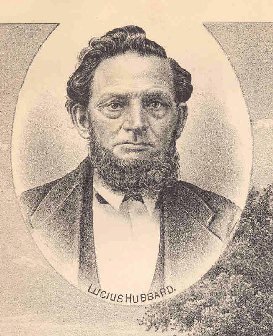

| Dayton lies on the western border of the county, and is the second town from the north. East is the town of Persia, and south the town of Leon. On the north is Perrysburg from which Dayton was erected on February 7, 1835, to embrace all of township 5, range 9, of the Holland survey. The area is 23,137 acres whose surface is less broken than that of most other towns. The northern and eastern parts of the town are elevated and irregular, the summits of the hills being a few hundred feet higher than the general level. In the central, southwestern, and western parts of the town, the surface is mainly level, and in some places not enough undulated to afford natural drainage. This forms a swamp, whose outlet is Connewango Creek, a very sluggish stream. Along the water courses, the town was originally heavily timbered with forests of pine and hemlock, a considerable portion of which yet remains. On the uplands, the timber was chiefly maple and beech, and was not so heavy as on the flats; but while the work of clearing the ground was less, the soil is not so strong and productive as on the lowlands. These were at first not esteemed valuable for farming, but since the lands have been improved, constitute the best part of the town. The soil here is a loam, more or less admixed with clay. On the hills it is a light loam, with a mixture of gravel or clay. The principal products are oats and hay; and at present dairying is the controlling industry. The streams of the town, draining north, are tributaries of Cattaraugus Creek, and are no larger than brooks. The affluents of Connewango Creek, flowing from the east, northeast, and northwest, unite in the southern part of the town to form what is usually known as the east branch of Connewango Creek. The volume of this stream is great, but is has but little fall, and such low banks that little power is afforded. Nor do the banks restrain the water in times of freshet, rendering useless much of the land bordering on these streams, on account of untimely overflows. The proposed improvement of the lower |
Connewango would greatly promote the current
of the headwaters, whereby a large portion of this land might be
redeemed for farming purposes. In that event, the southern part of
the town will become the richest and most productive section,
although the last settled.
THE PIONEER SETTLEMENTSwere made in the northern and eastern parts
of
Dayton. A list of the lands owned in 1819 contains the following
names:
|
|
Some of these resided on their lands at this time, and nearly all
became actual settlers in the course of ten years. A few of the
first only can be noticed in detail. In the fall of 1810, Simeon
BUNCE and his brother-in-law, Silas NASH left Otsego County to find
a home in the western part of the State. They had heard of
Chautaugua County and determined to locate there; and when they
took up their lands on Lot 64, they believed them to be in that
county. Each articled 100 acres, at eighteen shillings per acre,
and at once made substantial improvements, NASH building a log
house the same year, the first in the town of Dayton, which his
family occupied. In this humble pioneer home occurred the first
birth in the town, in June, 1811,-a son who was named Aras. Here,
also the following year in the month of February, came the angel of
death to claim his first sacrifice, - Dewitt, another son of Silas
NASH; and thus the house of rejoicing became a house of mourning.
Silas NASH put up the first sawmill in town in 1817 and continued
for many years a leader among the early settlers, holding many
positions of honor and trust in Dayton. His descendants also became
active, energetic citizens, some of them attaining prominent places
in the affairs of the county.
Simeon BUNCE was a native of Connecticut, having been born at Hartford in 1788. To this State he returned in 1813 and brought on his father's family to the home he had made on Lot 64 in Dayton. He had three children, one of whom survives, a son who occupies the old homestead-and here BUNCE lived until his death in 1875. Timothy M. SHAW came from Herkimer County in 1814, and located a piece of land on Lot 31. To this place he brought his family, consisting of wife and one child, the following year. He was accompanied by Heman and Anson C. MERRILL from Onondaga County. The former settled on the same lot as SHAW and Anson C. on Lot 30. Both occupied these places until their death, leaving many descendants in the county. SHAW died in 1872. A son, James S., lives in Dayton and another son, C.H., in Perrysburg. Ralph JOHNSON from Connecticut, came in the latter part of 1815, and settled on Lot 30. He was a tanner and currier by trade, and followed this business in town until 1865. He was also an early innkeeper, and the first postmaster of the Dayton office. He remained in town until his death a few years ago. Joshua and Caleb WEBB, from Madison County, came the same year, 1815, and settled on Lots 55 and 56, being the first in that locality. |
At
the house of the former was held the first religious meeting the
following year. Ten years later, they became innkeepers at what is
now called the Cottage neighborhood. The WEBB farm was sold in 1833
to John H. RICE.
At South Dayton on Lot 58, Leman H. and James P. PITCHER were the first settlers in 1816. They did not remain in town very long but sold their interests to M.C. NICKERSON, who afterwards became a Mormon. This farm is now owned by Asa BARNUM. In the spring of 1816, Azariah DARBEE settled on Lot 54, where he made preparations to bring on his family the following year from his native place Rutland County, VT. The journey hither was made by ox-team. He set out on his place the first orchard in town, getting his trees from Hamburg, Erie County. His son, Azariah, now occupies this farm and is the oldest settler in town, residing on the original purchase. In March 1817, Samuel K. STRICKLAND came from Central New York and located on Lot 40, bringing with him his wife and son, Robert O. The streams on the way were crossed on the ice and many hardships were endured. The same year, Thomas NEWCOMB settled on Lot 46; William BLASDELL on Lot 30; and Nathaniel BLASDELL on Lot 37. Peter and Luther ALLEN, the latter a minor, came from Onondaga County, in 1818, and after some removals, settled on Lot 23. Luther ALLEN returned to Onondaga County for a wife and brought her to his home in Dayton on an ox-sled. In 1834, he put up the first frame house where the village of Dayton now is, and which is still standing. He removed to Gowanda where he died in February, 1847. In 1820, his brother Asahel came and located on the same Lot, No. 23, settling on the place now occupied by Norman M. ALLEN, who was born in this locality. Asahel ALLEN died in town about 1858. After this period, so many settlers came that it will be impossible to enumerate them all here. The REDFIELDS, PARSALL, SMITH, HUBBARD, BACON, PARK, AUSTIN, HAMMOND, JUDD, and many other prominent families came before 1830. The condition of the settlements can better be seen from a carefully-compiled list of actual residents and owners of improved property in 1833. The valuation of the buildings here given may be less than their actual worth, but the relative measure of the improvements is the same in each case. |
| Name | No. of Lot | Value of Buildings ($) | Name | No. of Lot | Value of Buildings ($) |
| Isaac Wait | 1 | 50 | Jonathan Palmer | 31 | 25 |
| David Milks | 1 | 45 | Heman Merrill | 31 | 110 |
| Peter Kellogg | 2 | 35 | Hale Matteso | 32 | 45 |
| Ephraim Dutton | 2 | 100 | Jonathan Milks | 38 | 90 |
| Jonathan Milks | 2 | 45 | R.E. Knight | 38 | 50 |
| Daniel C. Bassett | 3 | 40 | Garrett Parsall | 40 | 35 |
| Eleazer Hillibert | 3 | 60 | Samuel K. Strickland | 40 | |
| Norman L. Bacon | 4 | 40 | John Parsall | 40 | 50 |
| P. Collins | 4 | 40 | Thomas Newcomb | 46 | 30 |
| D. Loomer | 6 | 35 | William B. Smith | 47 | 50 |
| Wyman Hulet | 7 | 35 | Ebenezer Roberts | 48 | 50 |
| Daniel Guptel | 8 | 45 | John Hammond | 51 | 40 |
| Chapel Judd | 9 | 30 | Asa H. Nichols | 52 | 20 |
| Ezekiel Seekins | 9 | 40 | Alvah Cole | 52 | 80 |
| Leander Bacon | 11 | 40 | Stephen Sowle | 53 | 45 |
| Constant C. Bacon | 11 | 40 | Simeon Dryer | 53 | 95 |
| Peniwil Bacon | 11 | 40 | Lemuel Webster | 54 | 35 |
| Avery Park | 11 | 57 | Azariah Darbee | 54 | 45 |
| Abel M. Bacon | 12 | 45 | James Cadwell | 54 | 45 |
| Deloss C. Burdick | 14 | 65 | Caleb Webb | 55 | 125 |
| Horace C. Adams | 15 | 40 | William B. Smith | 55 | 120 |
| Artemas Coon | 16 | 10 | John H. Blish | 56 | 100 |
| Sidney Park | 19 | 45 | Goodale & Wheeler | 56 | 130 |
| Russell J. Burdick | 20 | 40 | Thomas Newcomb | 56 | 35 |
| John Wattenpaugh | 22 | 45 | Isaac P. Hubbard | 56 | 35 |
| Asabel Allen | 23 | 35 | M.C. Nickerson | 58 | 130 |
| Luther Allen | 23 | 40 | George Passmore | 59 | 20 |
| Reuben Robertson | 23 | 90 | Tilly Sandord | 59 | 40 |
| William Farnsworth | 24 | 40 | Sylvester James | 60 | 50 |
| E. Dutton | 29 | 45 | Isaac Holbrook | 61 | 35 |
| Ralph Johnson | 30 | 250 | Nathan Bumpus | 62 | 35 |
| Anson C. Merrill | 30 | 225 | Silas Nash | 64 | 190 |
| Gile Johnson | 30 | 45 | Simeon Bunce | 64 | 100 |
| Timothy M. Shaw | 31 | 30 | Daniel Whelpley | 64 | 80 |
 |
 |
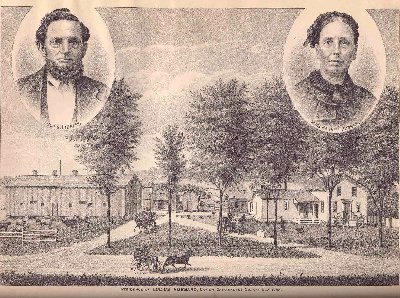 |
MANUFACTURING INTERESTS Owing to the limited
water
power in town, but little manufacturing was carried on as long as
this was the only motor. Silas NASH was the pioneer manufacturer.
In 1817, he put up a sawmill on the stream at West Dayton which he
operated a number of years. In a rebuilt condition the mill was
continued until 1856, among the later owners being J.R. RICE and
David SAUNDERS. About 1853, John KNOWLTON got in operation a steam
sawmill at West Dayton which has been improved and the capacity
increased. It is at present the property of John CRANDALL.
On Lot 30, Colonel Ralph JOHNSON began the business of tanning soon after his settlement in 1815. His first vat was hollowed out of a large log. Gradually, his facilities were increased until he had, about 1830, a pretty fair tannery, which at a still later period contained 12 vats. The tannery was carried on until about 1865. About 1830, Ralph JOHNSON and Anson C. MERRILL put up a sawmill in this locality, and on its site, a mill is yet operated by Henry MARKHAM. It has a capacity of three thousand feet per day. MARKHAM also operates a shingle mill, put up in 1862 by Henry WOLF. Five men are employed in the manufacture of fifteen thousand shingles per day. Gorham DART was an early shingle manufacturer, building in all three mills in the "swamp," and manufactured a large portion of the timber there growing. Some of these mills were removed to other parts of the town, and afterwards operated by Moses DART and C.L. WATKINS. The same may be said of sawmills. After being operated a period in one locality, they were removed when the timber supply was exhausted, to a more favorable place. In 1873, WATKINS & TARBELL removed their mill from the East Leon neighborhood to Dayton, and in 1877, the mill operated at the Jamestown crossing was removed by Henry WOLF to Lot 22, below Dayton Village. Here it was continued until June 12, 1878, when it was demolished by the explosion of the boiler. The disaster was accompanied by the loss of four lives, killing almost instantly, Henry WOLFE and his son William, Joseph HARBINE, and the engineer, a Norwegian named FRONDS. Two others employed in the mill had a narrow escape. William WOLFE has a combined saw and shingle mill below MARKHAM'S and in the same locality Jacob DURSEY has at present a shingle mill in operation. |
At Dayton Village are
C.L.
WATKIN'S planing mill, sash and door factory, established in 1874.
The motor is from a fifteen horsepower steam engine, which also
operates a small feed mill and, in season, a cider mill. These
industries occupy a large shop a short distance from the railroad
depot. Here is, also, Fernando SMITH'S stave and heading factory.
Work was begun in 1875, and employment is given to fifteen men in
the manufacture of from two hundred thousand to three hundred
thousand staves per year, most of which have been worked into
barrels on the ground. The product last year was fifteen thousand
apple, and six thousand flour barrels. The power is furnished by a
good forty horsepower engine.
At Pine Valley, a shingle mill was built in 1852 by WALLACE and William RANLETT, and operated by them six years. Machinery was then supplied to saw lumber and about that time, John WICKHAM became interested in its operation. Other changes of ownership followed, and it is at present the property of BURKHALTER & WICKHAM. It has a forty horsepower engine, and can cut six thousand feet of lumber per day. Planing and matching machines have been added, and it is now a complete lumber manufacturing establishment, employing ten men. At the railroad depot, Jesse PILE erected a lumber mill in the spring of 1878, which is supplied with a twenty-five horsepower engine and saws, capacitating the mill to cut eight thousand feet per day. Farther down the railroad track, C.J. BABCOCK & Company established a stave and heading factory in 1878 which is yet operated by them; and the same year PALMER & HALL put up another factory at which one thousand heads and ten thousand shingles are made daily. Box material is also manufactured. A small broom factory is in operation at Pine Valley, and several good carriage shops are also there carried on. THE DAIRY INTERESTS OF DAYTONThe dairy interests of Dayton have become so important that they constitute the leading industry of the people. Formerly large private dairies were maintained, but at present, the greater portion of the milk is manufactured at the different creameries in town, at this time seven in number. One of the largest, the East Leon factory, is in the southeastern part of the town and partly in Leon, in whose history it is fully noted. |
|
The West Dayton Cheese
Factory was erected about 1866 by Andrew BRAINARD. It is a good
building, thirty-four by one hundred and twenty feet, two stores
high, and is supplied with three vats. William MC ADAMS is the
present operator, employing the cheddar process in the manufacture
of from ten to twelve cheeses per day, which bears an excellent
reputation in market.
The Dayton Creamery was put up in the village of Dayton in 1866 by Porter WELCH, of Gowanda. It is thirty-three by one hundred feet, three stories high and is one of the most complete and best appointed factories in the county. When first operated, it had a large number of patrons, and consumed the milk of five hundred cows. Owing to the establishment of other factories in the northern part of the town, this creamery has not been operated the past year. Seth BARTLETT'S Cheese Factory, at MARKHAM'S Station, a two-story building, whose dimensions are thirty by eighty feet was put up in 1875, and is now successfully operated by JOHNSON & BARTLETT. It has a good patronage and the usual complement of cows. JENKS AND ROSS' Factory, on the MC FARLAND farm, has been operated since 1877. It consists of a good-sized main building and a wing. The milk of from one hundred and fifty to two hundred cows is here manufactured. The East Dayton Factory, at HOWARD'S corners, was built in 1874 by HALL and PARK. It is now the property of Rowlain HALL, who manufactures butte rand cheese from the milk of three hundred cows, owned by fifteen patrons. The Lang, or South Dayton Factory, on the south side of the swamp on the Jamestown Road, was put up in 1872 by Isaac LANG and has been operated by him since. There are sixteen patrons. Full cream cheese is manufactured from the milk of two hundred cows. |
HAMLETS AND VILLAGES The oldest hamlet in town
is West Dayton. On account of its location on one of the principal
highways, it was in early times, a place of much more importance
than at present, although it is yet entitled to a respectable
position among the many hamlets of the county. It contains a
sawmill, store, shops, a Methodist and a Union Church, and about
twenty-five dwellings. The post office is called Cottage, and was
established after 1850, having John H. BLISH as the first
postmaster. N.M. ALLEN was the next appointee and the subsequent
ones have been I.H. ALDEN, L.W. DAY, Charles BLAIR, and D.S. ALDEN,
the present incumbent. The first mail was supplied from SMITH'S
mills, Chautauqua County, and afterwards from Perrysburg, the
present from MARKHAM'S Station.
John H. BLISH was the first to engage in trade sometime about 1845. Four or five years later, John KNOWLTON opened a store. S.W. DAY, Barzilla MERRILL, and I.H. ALDEN were afterwards in trade. The present merchant is D.S. ALDEN. The first public house in town was opened at this point in 1824 by Joshua and Caleb WEBB. In after years, the former had another tavern on the BLISH place. John H. BLISH, J.H. RICE, Daniel WHELPLEY, L. & G. FLOWERS, and others followed as the keepers of public houses; FLOWERS being the last to have a tavern. In the southeastern part of the town, at the junction of the Jamestown and other roads, a hamlet sprung up about 1830 which received the name of Sociality. |
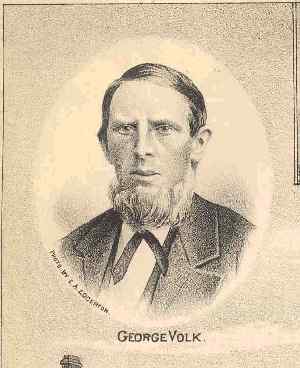 |
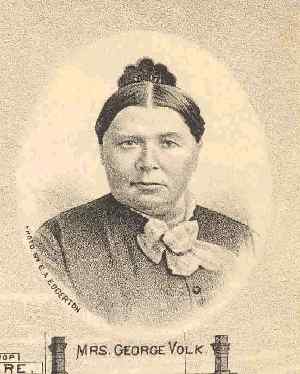 |
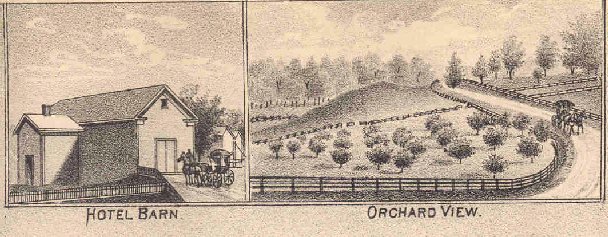 |
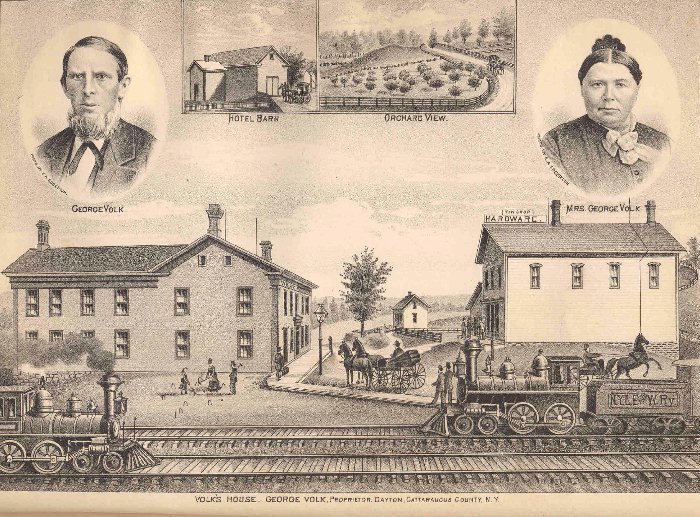 |
SOCIALITY This name was also
applied
to the post office, which was established before 1833, with Ephraim
DUTTON as postmaster. It was the first office in town, and was
continued until the Erie Railroad was completed through this
section of the county, when other offices were established so that
the business of the Sociality office became too meagre to warrant
its longer continuance. Nelson HILLEBERT was the last
postmaster. At this place, William H. LELAND
opened the first store in town in 1833. He had also a public house
and continued the keeper of both about ten years. Franklin
PHILBRICK afterwards kept a store and Harry HOWARD the tavern, and
as "HOWARD'S Corners" this place is yet locally known. After
HOWARD's retirement from this house, Leander BACON became the
keeper, and others, for short periods were here as landlords; but
the suspension of travel on the Jamestown Road, after the railroads
were built, caused the house to be used for other purposes, and the
only place of business at present is a grocery store by C.W.
HALL. In the huddle are a few mechanic shops, a cheese
factory, and a very neat Methodist church.
North of the centre of the town is another hamlet, generally known as MARKHAM'S Corners. MARKHAM'S CORNERS
It derived its name from
Joshua MARKHAM, who became a resident here in 1834, and soon after
opened a tavern which he continued about thirty years. In this
vicinity, Colonel Ralph JOHNSON had another public house, from 1845
on, continuing a number of years, and the building is at present
occupied by Leonard METSKER for a grocery store. Near here was
formerly a post office which was removed to Dayton Village. In
1876, a new office was established having John WALLACE as
postmaster. The name of this office is like the station, MARKHAM,
of which WALLACE is also agent. Since 1875, he has had a small
store near the railroad. The place contains a cheese factory,
several sawmills, and half a dozen houses.
DAYTON
Dayton, a station on the
Erie and Buffalo and Southwestern Railroads, is in the northeastern
part of the town, principally on Lot 23. It has grown up wholly
since 1851 and largely since 1872. It contains a few hundred
inhabitants, a Catholic and a Methodist church, several factories,
half a dozen places of business, and two hotels.
|
The
first here to engage in business was A.W.W. CHAFFEE, in 1851. He
put up and occupied the building in which is now kept the post
office, and in which afterwards James H. CHAFFEE, James S. SHAW,
A.M. DE LONG, H.N. HOOKER, Spencer HORTON, Frederick MOORE, and
N.A. CHAFFEE were in trade. The latter has continued since
1868.
James RICE had the next place of business, a grocery, near the cheese factory. In 1866, Henry WAGNER erected a store building, which was occupied by James CURRIN. After its destruction by fire, it was rebuilt by him, but has been occupied by a general store since 1874, by A.M. HALL. Since 1870, Fernando SMITH has been in trade, handling general merchandise, and for the same period, M.P. ROBERTS has had a drug store. The hardware trade was established in 1874, in a building put up by the Buffalo and Southwestern Railroad for a supply store by LANGMAID & CHENEY. They were succeeded by John MARVIN, and he by John VOLK, who is at present in trade. The first furniture store was opened by J.M. PARMELEE, and is at present carried on by Marcus RHODES. G. FITZMORRIS has had a boot and shoe store a number of years, and a few smaller stores in the same branch of trade have been kept a short time in the village. The first public house in the village of Dayton was erected in 1852 by Colonel Ralph JOHNSON, and was kept four or five years by T.W. JOHNSON. This is at present continued by George VOLK. Nearer the railroad station is another hotel built by Charles SISSON, and now owned and kept by William EGGLESTON. The post office was established about 1836 at the house of Ralph JOHNSON, near MARKHAM'S, and was kept there until 1851, when it was removed to the village and James RICE appointed postmaster. His successors have been James H. CHAFFEE,, Jonathan SHEPARD, Spencer HORTON, A.M. DE LONG, and since 1868, N.A. CHAFFEE. There are four mails per day. Dr. Samuel REDFIELD was the first physician in town. He came in 1821 and located on Lot 39, following his profession until his death about 1835. Drs. SILL, JOHNSON, CANFIELD, SHUEY, and others were physicians a short time. Since 1852, Dr. M.P. ROBERTS has been located as a practicing physician at Dayton Village, and since 1877, Dr. D.A. DYE at MARKHAM'S. No regularly-admitted attorney lived in town until 1864 when N.M. ALLEN commenced practice at the village of Dayton, and has since continued there, having a fine office and a large practice. In 1872, W.S. THRASHER, one of his students, formed a partnership with Mr. ALLEN, which is yet continued. Other graduates from this office are I.R. LEONARD and E.A. HAYES. |
|
PINE VALLEY
Pine Valley is a
flourishing village in the southwestern part of the town on the
Buffalo and Southwestern Railroad, six miles from Dayton junction.
The locality was formerly known as South Dayton, and the post
office is yet known by this name. This office was established about
1860 with E.O. BEACH postmaster, who appointed John WICKHAM deputy.
The latter kept the office at his residence, and had the mail
brought from West Dayton twice per week. Henry T. RICE was next
appointed, and M. L. RANLETT is the present incumbent. The mail
service is twice per day. In the neighborhood where the post office
was on the West Dayton Road, the village had its beginning as a
hamlet and did not improve much until 1875. That year, the Buffalo
and Southwestern Railroad located a station, one hundred and twenty
rods southeast from the post office, and Robert F. EWING platted
thirty acres of the WICKHAM farm for a village, extending from the
station westward. This was the beginning of Pine Valley proper, and
on this plat, N.L. ROWE put up a small store building that year.
The following season, EWING put up the first large building on the
new plat, and many residences were erected the same season.
John WICKHAM platted an addition of thirty acres to EWING'S Pine Valley in the fall of 1875, and since that period the place has had a rapid but healthy growth, containing at present seventy-five buildings, many of large proportions and fine architecture. It is the largest shipping point on the railroad between Jamestown and Buffalo, and has an increasing trade, which makes its future promising and very auspicious. In this locality David BARRETT was the first in trade, keeping a grocery store on the West Dayton road about 1862. In the same building John WICKHAM opened a store in 1872, but the following year occupied a new building, which is now the business place of RANLETT & CHASE. |
At the station, besides A.L. ROWE,
EWING & WHIPPLE are engaged in general merchandising and nearby
a hardware store was opened in 1878 by WILSON & WADE. The first
tavern was in a house changed for this purpose by A.B.
CHARLESWORTH, and was kept a number of years. It is again a farm
house and the only hotel is the "WICKHAM House," at the station,
which was erected in 1877 and occupied in 1878. It is sixty by
sixty-two feet and three stores high, and presents an attractive
appearance.
THE PUBLIC SCHOOLS In 1835, the
Commissioners
of Common Schools, James CADWELL, Russell BROWN, and W.B. SMITH
reported four whole and five fractional districts in town in which
an aggregate of forty-three months of school had been taught, in
terms of from three to seven months in each district. The number of
children taught was three hundred and sixty-five, and the money
apportioned to the town by the county was $121.15.
There are at present nine school districts, owning buildings and lots valued at $3,600; in these two hundred and seventy-seven and four-fifths weeks of school were taught at a cost of $2,246.35 for teachers' wages; the apportionment from the county was $1,170.68, and the amount raised by taxation $1,222.39. The number of children of school age was reported as four hundred and eighty-five, and the average daily attendance a little more than two hundred and seven. In most districts, good school houses have been provided and the reputation of the schools will bear comparison with those of other towns. District No. 2 is the owner of a fine grove near Dayton Village, which is locally known as "Educational Grove." It contains about five acres of well-drained ground, covered by a magnificent growth of maple trees. It is a favorite place for picnics and public outdoor |
|
gatherings. It was and is the purpose of the
purchasers to have the school buildings erected on these grounds
the present year, 1879.
RELIGIOUS SOCIETIES It is generally believed
that the Rev. Elnathan FINCH, a Baptist missionary, held the first
religious meeting in town in 1816 at the house of Caleb WEBB at
West Dayton. It does not appear that any society was organized in
consequence, immediately or in the years following. It seems that
the settlements were too sparse to maintain a church organization,
and no effort was made in this direction by the Baptists. But in
the fall of 1818, a class of four Methodists was formed, and met
for worship at the house of Caleb WEBB. The members were WEBB and
wife, Daniel and Clarinda BRAND. The meetings were led by a Mr.
WHIPPLE, living at Kent's Mills; and occasional preaching was
supplied by Revs. Dennis GODDARD and Samuel R. BROCKWAY. Soon the
class was augmented by members from the WEBB, DARBEE, and PROSSER
families, and shortly after a log meeting house was built on the
land of Daniel PROSSER, in southwestern Perrysburg which was used
until 1845. From this class was formed
THE FIRST METHODIST EPISCOPAL CHURCH IN
DAYTON
or what is now known as the Cottage
Methodist
Episcopal Church. The incorporation was effected October 31, 1845,
at a meeting over which Daniel PROSSER and John H. BLISH presided.
The trustees elected were Gile JOHNSON, William HOWLET, and John B.
REED. The membership of the church at this time was about sixty,
under the pastoral direction of the Revs. W.S. WARALLO and T.H.
CUMMINGS, preachers in charge of a circuit which embraced
appointments in Dayton, Perrysburg and other towns.
A church edifice was erected the following year, 1846, at West Dayton, which was replaced by the present structure in 1872. It is a very attractive place of worship, with a capacity to seat 300 persons, and cost to build $2,500. A parsonage and two acres of ground were secured for the use of Dayton circuit about twenty years ago, at West Dayton. |
This property is valued at $1,500, and is
occupied by the preacher in charge of the circuit, which embraces
other appointments in the town of Dayton. The pastorate is at
present filled by the Rev. A.H. BOWERS. Others who have served
Dayton circuit have been the Revs. W.W. WARNER, Peter BURROUGHS,
T.G. WHALON, T.P. WARNER, and L.A. CHAPIN. The names of the
ministry previously connected with the church can be found in the
history of the Methodist Church of Perrysburg. The present
membership of the church is not as large as it was at the time it
was formerly organized. A Sunday School is here maintained.
THE SECOND METHODIST EPISCOPAL CHURCH IN
DAYTON
The second Methodist
Episcopal Church in Dayton which was constituted of members living
in the eastern part of the town, was duly incorporated Marcy 8,
1848. A board of trustees was chosen composed of Avery PARK, Nelson
HILLIBERT, Norman L. BACON, Esek B. NASH, Aaron P. KNOWLES,
Jonathan PRINCE, and Benjamin J. ALLEN, to attend to the temporal
affairs of this body; but no church building was erected, and after
a few years, the society was allowed to disorganize. A class of
Methodists continued to exist, and meetings were held statedly, the
preaching being supplied by the pastors of the neighboring
churches.
On the 21st of April 1875, a meeting of these members was held in the school house at HOWARD'S Corners, over which the pastor, Rev. J.H. WHALLON, presided. A new organization was formed, to be known as the EAST DAYTON SOCIETY OF THE METHODIST
EPISCOPALCHURCH,
and B.J. ALLEN, O.J. NASH, Ansel A. NASH,
Esek
K. PARK, Charles W. HALL, L.O. HALL, and A.G. PARK were elected
trustees.
|
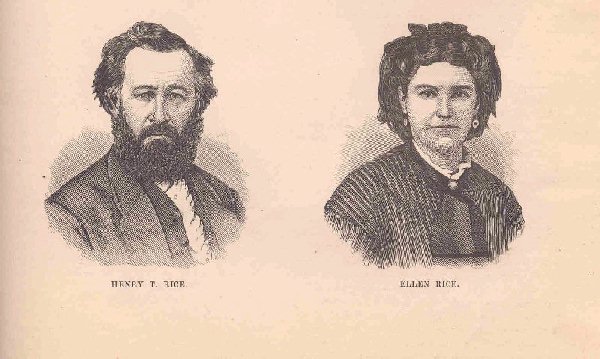 |
| Henry
Rice and Ellen Rice |
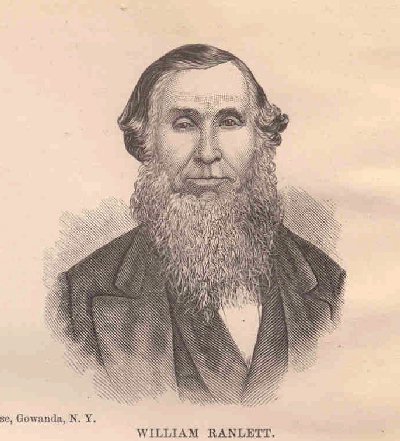 |
| William
Ranlett |
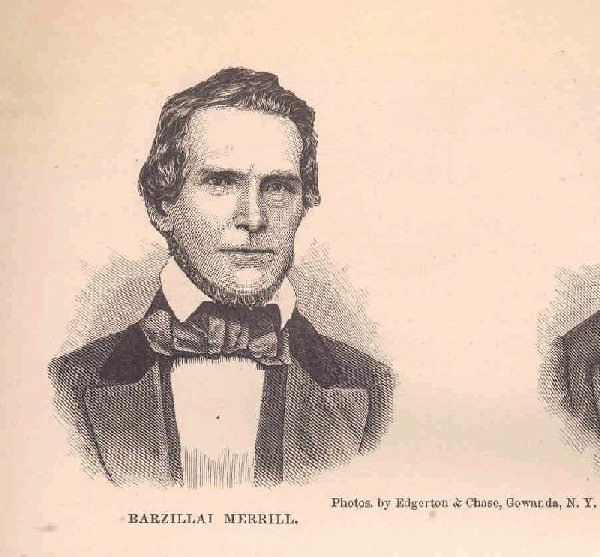 |
|
In the summer and fall of 1875,
a
very attractive church edifice was erected by this society at
HOWARD'S Corners. It is a frame, 30 by 45 feet, with a
well-proportioned front tower, and cost two thousand dollars. In
January, 1876, the church was dedicated with appropriate services,
conducted by the Rev. J.T. EDWARDS, of the Chamberlain Institute.
Here thirty-five members at present worship, and are under the
ministrations of the clergy of the East Leon Circuit, which
embraces this as one of its appointments.
A Sunday School, having forty members, is conducted under the superintendence of Ansel A. NASH. At Dayton Village was also, many years ago, a class of Methodists, which was organized into a church society in 1864 by the Rev. W.W. WARNER, at that time in charge of the Dayton circuit. On the 15th of May, 1875, the name of this body became THE SOCIETY AT DAYTON OF THE METHODIST
EPISCOPAL CHURCH
It yet remains a part of
the Dayton circuit, and has always been served by the ministers
from the Cottage Church. The present pastor is the Rev. A.H.
BOWERS, and the members number about forty.
In 1870, a comfortable church edifice was erected at a cost of nearly three thousand dollars, which was consecrated to the worship of the Divine Being the same year by the Rev. C.C. CARRUTHERS, presiding elder of the district. The property yet bears a neat appearance, and is estimated worth two thousand five hundred dollars. It is controlled by a board of trustees composed of E.C. BARTLETT, James RICE, A.T. GREGG, J.M. RICH, and A.M. HALL. THE FIRST FREE-WILL BAPTIST CHURCH OF DAYTON
The Free-Will Baptists
held
meetings in the eastern part of Dayton and the southern part of
Dayton soon after those sections were settled.
|
The organization of a church followed
these occasional services, May 4,
1831. Seven persons constituted the original membership, which
covenanted itself according to the rites of the church of which
they now became a part, and which was represented by the Rev. Amos
C. ANDRUS, the organizer of the new body. John SEEKINS was chosen
the first clerk, and the following year the Rev. Stacy SMITH became
the first regular pastor. His connection did not extend beyond a
year, the Rev. Hiram WHICHER becoming the spiritual tutor of the
church in 1833. The same year, William BARTLETT was chosen clerk.
In 1834, the Rev. F.B. TANNER was the preacher of the church, and
in 1835, the Rev. Freeman DARTE. The latter year, Lyman JUDD became
the church clerk.
In 1847, the church had forty-two members, and the Rev. MC KOON pastor; John SEEKINS, deacon; and William SEEKINS, clerk. In two years, Rev. Horatio PLUMB became pastor and the church was so prosperous that it was soon after determined to build a meeting house, the services up to this time having been held in private places and school houses principally in District No. 8. Here the society was duly incorporated February 16, 1852, with William WALDRON, Jonathan WAIT, Harrison JUDD, Daniel BROWN, Ezekiel SEEKINS, and John SEEKINS, as trustees. The church edifice, a plain frame structure, whose seating capacity is two hundred, was not completed until 1854, and was consecrated that winter by the Rev. J.H. BALL, of Buffalo. It is in the southeastern part of the town, near the Leon line and is now reported worth eight hundred dollars. When the church was built, Rev. George DONOCKER was the pastor, and about this time, Daniel BROWN was here licensed to preach. Subsequently he became the pastor of the church, and now minister of it. Among others who filled the pastoral office since 1855 have been Revs. J.H. LOVELACE, S. CROSBY, L.D. HOWE, J.C. STEELE, and Jerome HIGBEE. In 1878, the church had thirty-two members, George H. MOSHER, Frank JUDD, Walker INGERSOLL, Richard EASTON, Collins SPENCER, W.S. EASTON, trustees, and Harrison JUDD, church clerk. |
|
ST. PAUL'S CHURCH (ROMAN CATHOLIC)
St. Paul's Church at
Dayton
Village, was formed as the result of missionary meetings held here
in 1863 by Passionists from Dunkirk. In 1864, a small church,
capacitated to seat one hundred and fifty persons, was built in the
southern part of the village in which about ten families met
regularly for worship, and were under the spiritual tutelage of
Passionists, until Dayton became a parish with Father Charles C.
GEPPERT as the first resident priest.
In 1876, a fine church edifice, forty by seventy feet, with a handsome tower eighty feet high was erected on an acre of ground at a cost of nearly four thousand dollars. The tower contains an excellent bell, weighing six hundred pounds. A part of the church lot is used for cemetery purposes. There are at present fifty-three families and three hundred communicants connected with the church which has for its resident priest, Father WELCH. A Sunday school of thirty members, and a parish school for religious instruction are also maintained. THE GERMAN UNITED PROTESTANT ST. PETER'S
CONGREGATION
The German United
Protestant St. Peter's Congregation was incorporated September 3,
1864, and had for its first trustees Charles KOEPPEL, William
BORNEMAN, and John OCHSER. Previous to this period, a small but
neat house of worship had been built about four miles south of
Dayton Village. In the house, meetings have been held statedly by
the Revs. SHONSTEIN, FEGALE, and others, the congregation having no
regular pastor. The membership in consequence is small, and the
society not so prosperous as under more favorable
circumstances.
THE FREE UNION CHURCH
The Free Union Church was
erected at West Dayton in the fall of 1878, and consecrated October
31st by the Rev. Dr. HALL of Buffalo, and Rev. Mr. COOK of Cherry
Creek. It was built by the people of Cottage and
vicinity for the accommodation of any
|
persuasion, irrespective of creed, which may
choose to worship in it, and in its appearance and arrangement is a
very creditable edifice.
At Pine Valley, the Methodists hold meetings, with prospects of organizing as a church; and in other localities meetings are held by various denominations with a view to form organic religious societies. SECRET ORDERS Summit Lodge No. 72,
A.O.U.W., was instituted at Dayton Village, February 24, 1877, with
twelve charter members, and the following officers: E.O. HAYES,
M.W.; L.D. BARTLETT, G.F.; J.L. FENTON, O.; D.J. PIERCE, R.; A.M.
HALL, F.; N.A. CHAFFEE, Rec. There are at present thirty-six
members and the meetings are held in VOLK'S Hall.
The principal offices were filled in 1878 by M.H. MERRILL, P.M.W.; John LOCKE, M.W.; M.W. JOHNSON, G.F.; James L. FENTON, O.; and the three last-named officers of 1877. Valley Lodge, No. 704 K. of H., was instituted at Pine Valley, August 1, 1877 with eleven charter members. The first principal officers were B.H. LAMB, D.; J.S. Shults, P.D.; T.R. SIMPSON, R.D.; A.B. CHARLESWORTH, V.D.; George YOUNG, Jr., R.; E.A. CHASE, F.R.; Charles BERWALD, T.; D. RANLETT, G. Sixteen members were reported in November, 1878. The Valley Lodge Building Association was organized in April, 1878, with the following members: J.C. SHULTS, Charles BERWALD, Joseph LE BARRON, John LE BARRON, W. FOLEY, B.H. LAMB, E.A. CHASE, George YOUNG, Jr., John OAKS, D. RANLETT, George BURKHALTER. The object of the association is to provide a suitable hall for lodge and other purposes at Pine Valley. In the fall of 1878, a building 22 by 50 feet, two stories high, was erected at a cost of about one thousand dollars. To this place, the meetings of Valley Lodge will be transferred at an early day. There have been temperance societies and other secret orders in town, but the meetings have been discontinued, and their history, in consequence, cannot be here given. |
The subject of this sketch is in a large and emphatic sense, a "self-made" man, and he is recognized as a prominent and distinguished citizen of this county, and is worthy of such recognition.
Norman M. ALLEN was born in the town of Dayton, this county, December 24, 1828. His father, Luther and his mother, Huldah (BENEDICT) ALLEN, were natives of Onondaga County, N.Y., being born in the town of Fabius, from which place they emigrated in an early day to Cattaraugus County, and settled in the town of Dayton.
He was left an orphan at an early age, his mother dying when he was but ten years of age, and his father when he was seventeen. He was thus thrown upon his own resources at this early age, and was without adventitious aid; but by the force of his own talents, aided by an indomitable energy, he has made for himself a successful career, and has become distinguished in the affairs of this county, district, and State.
To his native talent, self-culture, and untiring energy, his success may be largely ascribed. His educational advantages were extremely limited, the merest rudiments of an English education being acquired by a few years' attendance in the common schools of his native town, prior to the death of his father, after which event he was compelled to commence the "battle of life" in earnest. His school days were ended at this early age, but not his hours of study. All the leisure moments he could find were, for many years, devoted to study, and he is still a hard student.
For several years after his father's decease, he taught in common schools in his vicinity in the winter, and worked at farming in the summer. He continued this course until his health became impaired so much that for three years he was unable to perform active outdoor labor. This period of his life was given to hard study, and his success was more remarkable from the fact that he had the aid of no teacher in his pursuit of knowledge; his thirst for knowledge was his only inspiration. Although he cannot claim a scholastic training, yet by his own unaided efforts, he has achieved an intellectual culture of which many college graduates might be proud.
At the age of nineteen in 1848, he married Huldah MERRILL, daughter of Heman and Amelia (HAWKINS) MERRILL. She is a native of Dayton, her parents having removed hither from Onondaga County, N.Y., and being among the pioneer settlers of the place.
He was admitted to the practice of law in 1864 at Albany, N.Y. During ten years prior to his admission to practice, he had been a diligent student of all the law books he could purchase with his scanty means, or that he could obtain in his vicinity. And from the fact that he pursued his legal studies in this manner, in no office and without an instructor, his success seems the more remarkable.
From the outset of his legal studies, he began to obtain employment in legal affairs, and became, almost at once, the legal adviser of his friends and townsmen, did much of their law business, drew writings, and tried causes for them in justice's court. His legal knowledge, business, and reputation continued to increase, until 1864, while serving his first term in the State Senate, he made the acquaintance of the Hon. Amasa J. PARKER, on whose motion he was admitted to practice as a lawyer in all the courts of this State.
From the time of obtaining his majority until 1855, he was in politics a Democrat; but since that date he has been a Republican. He has held varied and important political offices in his town, county, senatorial district, and State, the duties of which have been discharged with rare fidelity and integrity. For nineteen successive years, he has been elected supervisor of his town (Dayton), during fifteen of which he has been the chairman of the Board of Supervisors of this county.
In 1855, he was elected county superintendent of the poor upon the first Republican ticket nominated in the county, and held that office until 1857, when he resigned to accept the office of school commissioner, which office he held during the years 1858-60. His services in behalf of the common schools of this county, and his assistance and aid extended to teachers, are held today by many in kindly remembrance.
In 1861, he was appointed to the position of United States mail route agent, and held and discharge the duties of this position until February, 1863 when he resigned to accept the office of paymaster in the army, to which he had been appointed by President Lincoln, which station he only filled for a short time, resigning it to accept the office of assistant provost-marshal of the 31st Congressional District, which position he held up to the time of his first election to the Senate in the fall of 1863. In the election of that year, he was the candidate of the Republican party and was elected to the Senate over John C. DEVEREUX, Democrat, by 6,114 majority, being the largest majority received by any candidate of the Republican party in the district. Mr. Allen was again elected to the Senate in 1871, over Frank L. STOWELL, Democrat, by 4,276 majority. In the Senate of 1864 and 1865, he served upon the committee on literature and other important committees, and in the Senate of 1872 and 1873, upon the judiciary and other committees, and by virtue of his office as Senator was a member of the court of impeachment that tried and removed Judge BARNARD from office. In 1867, he was elected a member of the Constitutional Convention, receiving all the votes in his own town, save one, of all parties. That convention was composed of one hundred and sixty delegates, many of whom were then or have since become distinguished in the nation, embracing such names of William M. EVARTS, William A. WHEELER, Francis KERNAN, Samuel J. TILDEN, Amasa J. PARKER, Horace GREELEY, George William CURTIS, etc.
In the year 1866, Mr. ALLEN was appointed State Assessor, and held that position for four years. The duties of this office required him to visit all parts of the State in company with his two associates, and it is but justice to all of the members then constituting the board, to say that their equalization reports were accepted with less criticism and objection that the reports of that body have usually been received.
In 1868 and again in 1876, he was one of the candidates for elector upon the Republican electoral ticket.
During the years of the late war of the Rebellion, he did good loyal service in helping in the formation of regiments and in sustaining the cause of the country; and when the remains of the murdered President Lincoln were brought to Albany on their way to the great West, Mr. ALLEN was one of the pallbearers appointed by the Senate who attended the remains of the dead President during their stay at the capital of the State.
Mr. Allen is esteemed by his neighbors and acquaintances as few men are, and in a way of which any man may well be proud. Some of the reasons for it seem to be found in the fact that he is courteous and obliging to all, kind and generous towards poor men, never oppressive, and charitable to all deserving charities.
The family of Mr. Allen embraces four children: Mary A.F., now the wife of W.S. Thrasher, who is associated with him in legal copartnership; Kate C.D., the wife of W.W. BRAND of Dayton; Carlton W. ALLEN and Hoyt M. ALLEN, both being at home.
We cannot better sum up the salient points of Mr. ALLEN's character than by quoting the words of one of his political opponents, Col. J.T. HENRY, as given in his recently-published "Recollections" in the Olean Record:
"Mr. ALLEN is among the few representative men of this Senatorial district who have escaped sharp criticism and calumny in office. No suspicion of wrong has ever been breathed upon his record. He was ever conscientious, high-toned, faithful, and honest in all his public life and acts, and without a cloud or color as a private citizen. He was a member of the last Constitutional Convention,- Hon. George VAN CAMPEN of Olean, being his colleague,- where he attained distinction for his wise counsel and solid worth.
.....He has administrative ability of a high order, and discharges all his public duties with faithfulness and rare intelligence. A man who has seen so much of public life, and escaped political slander and vituperation, is an exception to the almost universal rule. Mr. ALLEN has accomplished this in ample measure. He has not only been unassailed, but has so conducted himself in public as to be entirely unassailable. He is yet in middle life, in the enjoyment of excellent health, a large practice, and enough of this world's wealth to keep "the wolf from the door," and insure his declining years from care or anxiety on this account."
Ralph Johnson and Mariah Johnson
GILE JOHNSON
Gile JOHNSON, the fourth son of John and Althea WATKINS JOHNSON, was born in Stafford, Connecticut, in the year 1804, and soon after removed with his parents to Herkimer County, N.Y. When seven years of age, he, with his five brothers and a sister became orphaned by the death of his father. His mother unable to provide for so large a family with her limited means, found a home for him in the family of a Mr. GRISWOLD, a farmer of that county, with whom he lived until he was twenty-one years of age. In 1826, he came to Cattaraugus County, N.Y. and bought a farm, adjoining his brother Ralph's, in the town of Dayton which, like the entire surrounding county, was a dense forest, and which by his energy and industry, was soon cleared up and with an occasional addition of fifty or a hundred acres, occupied by him till his death, which took place December 7, 1872. Two years after purchasing his farm, he married Philena SALISBURY, daughter of Calvin SALSBURY of Herkimer County, N.Y., who died in 1839, leaving three little boys. He soon after married Milley, daughter of Calvin and Hannah RICH, of New Albion, who died in 1858, deeply lamented by her numerous friends and acquaintances, especially by her family, consisting of two sons and four daughters, besides the sons of her adoption, all who are now living, excepting his eldest son who died from disease contracted in the army. He afterwards married Rosalinda HUBBARD of Dayton who lived but a few months; and in 1860 he married his present surviving wife, Mrs. Sarah Ann BAILEY, daughter of Nathaniel HURD of Perrysburg, whose portrait is given elsewhere, who now lives on the old homestead, honored and respected by her husband's entire family. Her residence is soon in the engraving near where the subject of this sketch lived and died. Her son, by a former marriage, also makes his home there when off from duty, being a naval officer.
In early life, he became connected with the Methodist Episcopal Church of Dayton of which he remained a faithful member through life, and had the satisfaction of seeing nearly all his family honored members of the same. Besides being a constant officer in the church, he also was twice elected to the office of supervisor, and often held other responsible offices in his town.
Like most men who accumulations depend upon their own industry, he was prudent and economical; yet he would not on any account take advantage of the necessity of others. At an early day, during a period of scarcity of wheat, many of his neighbors were suffering for want of it; and when it could be sold for several dollars per bushel, he would sell his wheat for one dollar per bushel, and would sell but a few bushels to each individual; and also during periods of scarcity of hay, when his neighbor's cattle were starving for want of it, and when it could be sold for a fabulous price, he would sell his hay for ten dollars per ton, and divide it among his neighbors, according to their necessity. He was conscientiously honest in all his dealings. In regard to his farm work, his motto was "drive your work, and not let your work drive you." In all business transaction, he was punctual and prompt to meet all contracts and engagements. He took a deep and lively interest in the welfare of his family, and was a kind and affectionate husband; and his example in life was in perfect harmony with his Christian profession.
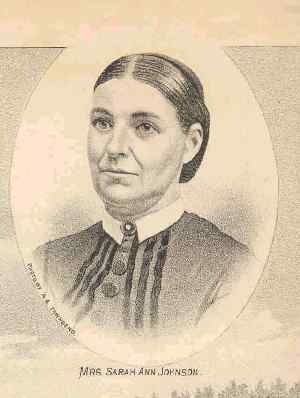 |
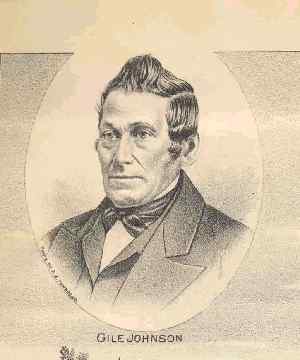 |
|
| Mrs
Sarah Ann Johnson |
Gile
Johnson |
 |
 |
|
| James
M.Rich |
Matilda
Rich |
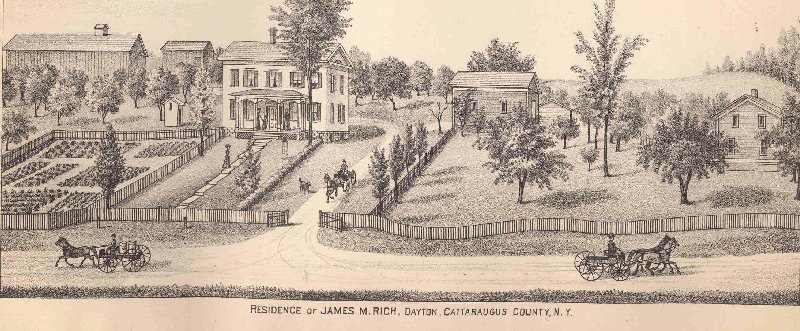 |